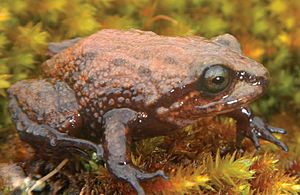Attenborough's rubber frog facts for kids
Quick facts for kids Attenborough's rubber frog |
|
|---|---|
 |
|
| Holotype, a male | |
| Conservation status | |
| Scientific classification | |
| Genus: |
Pristimantis
|
| Species: |
attenboroughi
|
Pristimantis attenboroughi, also known as Attenborough's rubber frog, is a special kind of frog. It belongs to the Strabomantidae family. This frog lives only in the Andes mountains of Peru. It has been found in and around the Pui–Pui Protection Forest. This frog is extra special because it's the first amphibian named after the famous naturalist, David Attenborough.
Scientists Edgar Lehr and Rudolf von May discovered this frog. They spent two years studying the forests of Peru to find it. They described the species after studying 34 frogs. These frogs were found at very high places, between 3,400 and 3,936 meters (about 11,155 to 12,913 feet) above sea level.
Contents
What Does Attenborough's Rubber Frog Look Like?
Adult male frogs are about 15 to 19 millimeters (0.6 to 0.75 inches) long. Adult females are a bit bigger, measuring 19 to 23 millimeters (0.75 to 0.9 inches) from their snout to their rear end. Their snout, or nose area, is short and rounded.
These frogs do not have a visible eardrum, which is called a tympanum. Their finger and toe tips are narrow and rounded. They don't have any extra skin flaps on the sides of their fingers or toes, and they don't have webbing between them.
The color of their back can be light gray, reddish brown, or brownish olive. They often have small spots or flecks. Some even have an X-shaped mark on their shoulders. Most of these frogs have dark grayish-brown stripes. These stripes run from their nose area (called canthal stripes) and above where their eardrum would be (supratympanic stripes). Young frogs are lighter in color, usually yellowish to reddish brown. They have clear dark brown spots and very noticeable stripes near their eyes.
How Do These Frogs Reproduce?
Pristimantis attenboroughi frogs reproduce in a unique way called "direct development." This means that when the eggs hatch, tiny froglets come out directly. There is no free-swimming tadpole stage like with many other frogs. The eggs are about 3.5 millimeters (0.14 inches) wide.
Where Do Attenborough's Rubber Frogs Live and How Are They Protected?
Attenborough's rubber frogs live in high mountain forests and high Andean grasslands. These areas are very high up, between 3,400 and 3,936 meters (about 11,155 to 12,913 feet) above sea level. Scientists found these frogs living inside soft moss pads. One female frog was even found guarding a group of 20 eggs inside some moss.
Even though this frog lives in a small area, which might make it seem "endangered" or "vulnerable," experts have a different view. In 2018, the International Union for Conservation of Nature (IUCN) decided that this species is "near threatened." This means they are not in immediate danger. They chose this category because the total number of these frogs seems to be stable. Also, they are quite common in their habitat, and much of the area where they live is protected.
See also
 In Spanish: Pristimantis attenboroughi para niños
In Spanish: Pristimantis attenboroughi para niños



